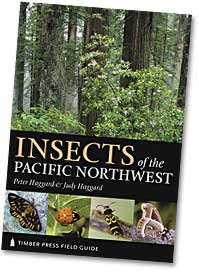|
COVER STORY | IN
THE NEWS | FROM THE PUBLISHER | DIRT
| STAGE MATTERS April 13, 2006
Insects of the Pacific Northwestby AMY STEWART Pete Haggard didn't take a vacation for ten years. Why? There was no one to watch the bugs. Haggard, a Humboldt County agricultural inspector,
began photographing and cataloging northern California insects
over a decade ago. The result is a new book from Timber Press,
Insects of the Pacific Northwest, which he co-authored
with his wife Judy, a wildlife biologist. Often, the only way
to get the pictures he wanted was to raise them himself. "For about ten years," he said, "I'd go out on Saturday mornings and take pictures of the insects I found. But it's hard to find them in their immature stages, so I'd look for the host plants and gather eggs, then bring them back and raise them in the house in five-gallon buckets." Maintaining an insect nursery is a complicated endeavor. "It's not like a dog or a cat," he said. "You can't leave a hundred different insects with somebody and go away. They're like babies; they have to be cleaned every day, they need fresh foliage and you have to check them twice a day to see if they've hatched." Moths and butterflies in particular are tricky; if they emerge, they need to be released or they will beat themselves against the glass. "You can't get a good picture after even a day or two," Pete said, "because they start losing scales that quickly." In fact, to make sure his little darlings stuck around long enough to pose for a picture, Pete would often put them in the fridge to cool them down and slow their metabolism. That way, when they got outside, they'd sit still for the camera. He was quick to assure me that this wasn't a cruel practice. "Cold isn't the same for insects as it is for humans," he said. "It just slows down their metabolism. It isn't necessarily torture." (I asked Pete and Judy if they had a special fridge for the bugs, but no, they go in the regular fridge along with the milk and the vegetables. Larvae in film canisters would sometimes spend months in the crisper enjoying an artificial winter.) All that hard work and lost refrigerator space paid off, and the result is a comprehensive and user-friendly guide to the most common insects in northern California, Oregon, Washington and British Columbia. You'll see a wide variety of beetles, flies, ants, bees, butterflies, grasshoppers and some non-insects like spiders and snails. The Haggards, who tend a one-acre garden of native plants and fruit trees in Fieldbrook, decided early on that the book should include information about the host plants that provide food and shelter to insect eggs and larvae. "People want to attract butterflies," said Judy, "so they plant butterfly bush. You will get the adults, who like the nectar, but if you want to attract a suite of insects to your garden so they'll really make it their home, you need the host plants where they can lay eggs." The lovely garden tiger moth, for instance, feeds on plantain, lupine and dandelion, three plants gardeners might not otherwise consider cultivating, and the gorgeous yellow western tiger swallowtail needs willow, poplar, sycamore and alder to start a family. The book makes fascinating reading for gardeners as well as hikers and wildlife enthusiasts. For instance, one common species of snail, the robust lancetooth snail, actually preys on other snails and should be considered a friend to gardeners. (I'd like to issue a formal apology to the 4,000 or so robust lancetooth snails I have probably flung into traffic over the last several years. Why didn't you say something?) Another interesting insect gardeners should look out for is the glowworm beetle, which may be visible on damp nights thanks to its luminescent segments. The presence of these glowworms is a sign of a healthy, diverse insect population; Pete brags that his garden is teeming with them. The Tiemann's glowworm seems to embody the notion that love conquers all; although the male is a small, skinny black beetle 14 mm in length and the female is large, segmented worm-like creature 65 mm in length, they still seem to -- well, make it work. If you see them in your garden, cheer them on. There's drama as well as romance in this book. Another glowworm, the western banded glowworm, consumes millipedes by injecting them with a chemical that liquefies the millipede's flesh, then eats the contents, one segment at a time, leaving a neat pile of disconnected rings at the end of the meal. The Haggards hope that people who read their book will appreciate the enormous diversity in their local insect population. "People tell me they saw a show on the Discovery Channel about beetles of the Sahara or something like that," Pete said, "and sometimes I think we know more about tropical insects than the ones here at home. We may not have butterflies the size of pigeons, but if you look through the book, there's a lot of color and a lot of beauty." Pete and Judy Haggard are taking their bug show on the road. Meet them at the HSU Natural History Museum on Saturday, April 22, from 1 to 3 p.m., where they will present a slide show and sign copies of their book. You can also see Pete at the California Native Plant Society's Spring Wildflower Show at the Manila Community Center on May 6 and 7 from 10 to 5 p.m. The book is available now at bookstores around town.
Send your bugs to amystewart@northcoastjournal.com, or write in care of the Journal at 145 G St., Suite A, Arcata, 95521. COVER STORY | IN
THE NEWS | FROM THE PUBLISHER | DIRT
| STAGE MATTERS Comments? Write a letter! © Copyright 2006, North Coast Journal, Inc. |


